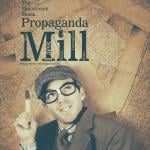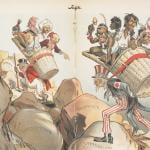I have been posting about the extreme violence that characterized US life around the turn of the twentieth century, roughly between 1877 and 1917 – all the private armies and paramilitary activity, the massacres and ethnic wars, the prevalence of political murder and assassination. These currents set the US far apart from most other parts of the advanced world at this time, and I’d like to explore the reasons why.
Europeans at the time were very conscious of this American Difference, and by no means only in terms of the Wild West. You get a sense of this from the Sherlock Holmes stories of Arthur Conan Doyle, which so regularly used the pervasive quality of American violence as a plot device. And more specifically, the organized private violence manifested in militias, terror movements, and death squads. The very first Holmes story, in 1887, was A Study in Scarlet, which concerned Mormon Danite death squads wandering London. Over the next decade, The Valley of Fear covered the Molly Maguires, Five Orange Pips dealt with Ku Klux Klan assassins, and Chicago gangsters appear in The Adventure of the Dancing Men.
Incidentally, Doyle presented a remarkably radical vision of contemporary US race relations and Reconstruction, due in part to his contacts with African-American intellectuals. Five Orange Pips is quite explosive in this way, and so were early drafts of some other stories, including The Adventure of the Yellow Face. I am struggling to avoid spoilers here, but if you have not read Yellow Face, you won’t regret it. (If you are a fan of the TV series Sherlock, Yellow Face is quoted obliquely in The Six Thatchers).
When Bram Stoker needed a heavy to confront Dracula (1897), he created Quincey Morris, a Texan hero (what else?) with his ferocious Bowie knife.
A traditional explanation for the American difference was the presence of the frontier, which through much of the nineteenth century created such violence and instability. We see some evidence for that in states like New Mexico, where exceedingly bloody faction feuds were partly driven by a scramble for millions of acres of land. On the other hand, much of the worst violence had nothing to do with frontiers in any conventional sense, and battles were taking place in the long settled east and south.
One major difference between the US and Europe was the power of the central state. In the vast subcontinent that was the US, it was very difficult for any regime to expand its power over the whole continent, while the federal government was deliberately kept weak in internal matters. This opened the way for struggles for control of individual cities, states and regions, commonly for private profit. Nor could government regulate industries and labor activities during the era of surging industrialization, and union activities were still on the fringes of legality as late as the 1930s. American labor leaders had to be adept at mob activities, at sabotage and overt violence. This placed the US at least a couple of generations behind Western Europe, probably more.
Violence certainly occurred in European nations in these years, but significantly it was focused on control of central power, unlike in the US. France, for instance, managed to have a revolution or civil war every couple of decades between 1789 and 1871, and it came close to repetition with the Dreyfus affair of the 1890s, and the church-secular conflicts after 1900.
Most European nations had substantially calmed private violence by the eighteenth century, and channeled what remained into acceptable outlets on behalf of the state. Empires played a critical role here. While Britain, for instance, had strikingly low violence rates in the late nineteenth century, adventurers carried their energies to imperial territories, mainly in Africa, where they behaved abominably. Germans, likewise, managed to export their lethal instincts, and after 1900 that empire launched authentically genocidal wars in its African territories.
When civilized Europeans watched violence in the US, they were appalled – not because their own people did not act like that, but because they had been trained to do those things elsewhere.
Europe did in fact have parallels to American violence, but only on the disreputable fringes, especially in the Balkans. In Russia too, private militias emerged as a powerful force after 1900, with the anti-Semitic Black Hundreds.
The main exception to this general pattern in Western Europe was in another restive border territory, namely Ireland, which often threatened to destabilize seemingly peaceful Britain. By 1914, the United Kingdom was on the verge of falling apart into civil war, a fate from which it was only narrowly saved by the outbreak of the First World War.
Transatlantic resemblances actually became much stronger from the end of the First World War onwards, with the undermining or outright collapse of state power across large sections of Europe. Meanwhile, ethnic communities confronted each other, and began what we would later call ethnic cleansing, while labor violence surged. The following few years were a golden age for militias and paramilitary groups, Freikorps units, and acts of individual terror and assassination. On occasion, those fighting units merged into overtly political parties, commonly fascist or Nazi. (See now Robert Gerwarth’s book The Vanquished: Why the First World War failed to end, 1917–1923).
The US actually had a precise analogy to these trends in its own Ku Klux Klan revival, which attracted millions in the early 1920s. Far from imitating Europe, though, Americans were just reverting to their older habits of paramilitary violence and lynch law. It was just that now, the Europeans were copying them.
Next time I’ll talk about one strand that runs through these habits, and one that never really gets the attention it deserves, namely concepts of honor.













